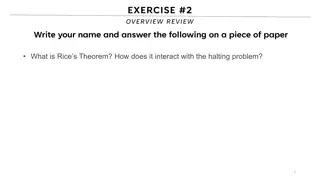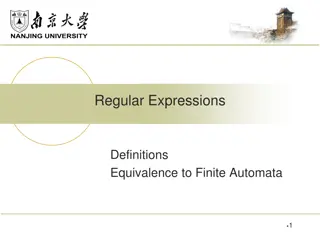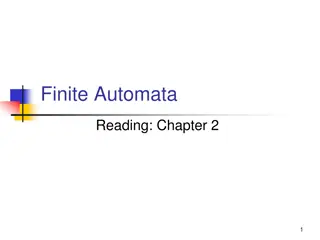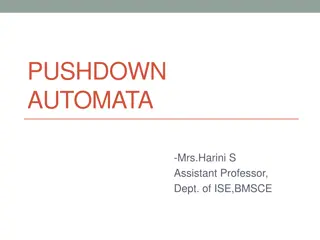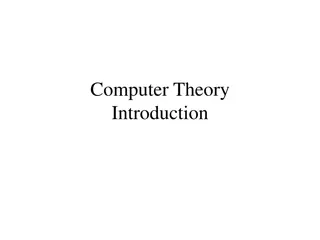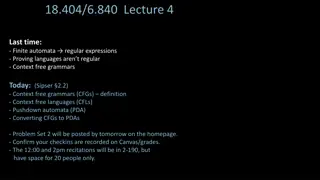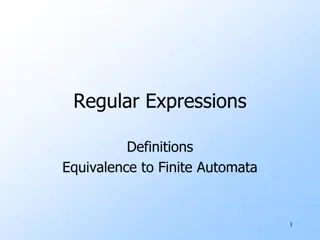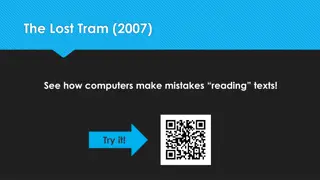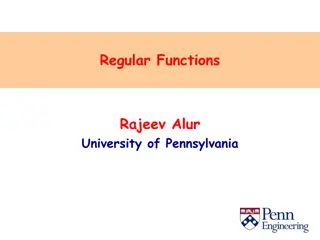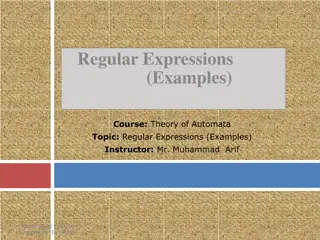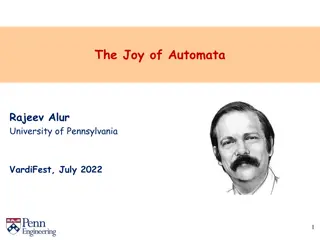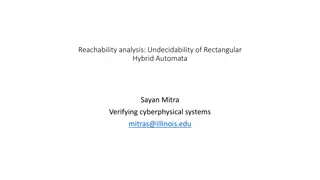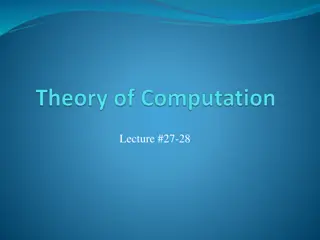Understanding Pushdown Automata (PDA) for Context-Free Languages
Pushdown Automata (PDA) is a crucial concept in the theory of computation, specifically for the recognition of context-free languages. PDAs are an extension of nondeterministic finite automata (NFA) with an added stack memory. This summary provides insights into the definition, transition functions, and operations of PDAs, highlighting their role in accepting/rejecting input strings based on stack symbols. Examples such as recognizing the language LwwR and constructing PDAs for specific CFGs offer practical applications of PDAs in language recognition and processing.
Uploaded on Oct 09, 2024 | 0 Views
Download Presentation

Please find below an Image/Link to download the presentation.
The content on the website is provided AS IS for your information and personal use only. It may not be sold, licensed, or shared on other websites without obtaining consent from the author. Download presentation by click this link. If you encounter any issues during the download, it is possible that the publisher has removed the file from their server.
E N D
Presentation Transcript
Pushdown Automata (PDA) Reading: Chapter 6 1
PDA - the automata for CFLs What is? FA to Reg Lang, PDA is to CFL PDA == [ -NFA + a stack ] Why a stack? -NFA Input string Accept/reject A stack filled with stack symbols 2
Pushdown Automata - Definition A PDA P := ( Q, , , ,q0,Z0,F ): Q: states of the -NFA input alphabet : stack symbols transition function q0: start state Z0: Initial stack top symbol F: Final/accepting states : : 3
new state(s)new Stack top(s) input symb. Stack top old state : Q x x => Q x : The Transition Function (q,a,X) = {(p,Y), } state transition from q to p a is the next input symbol X is the current stack top symbol Y is the replacement for X; it is in * (a string of stack symbols) Set Y = for: Pop(X) If Y=X: stack top is unchanged If Y=Z1Z2 Zk: X is popped and is replaced by Y in reverse order (i.e., Z1 will be the new stack top) 1. X Y a 2. q p 3. 4. Y = ? Action Y= i) Pop(X) i. ii) Y=X Pop(X) Push(X) Pop(X) Push(Zk) Push(Zk-1) Push(Z2) Push(Z1) ii. iii. iii) Y=Z1Z2..Zk 4
Example Let Lwwr = {wwR | w is in (0+1)*} CFG for Lwwr : PDA for Lwwr : P := ( Q, , , ,q0,Z0,F ) S==> 0S0 | 1S1 | = ( {q0, q1, q2},{0,1},{0,1,Z0}, ,q0,Z0,{q2}) 5
Initial state of the PDA: q0 Stack top PDA for Lwwr Z0 (q0,0, Z0)={(q0,0Z0)} (q0,1, Z0)={(q0,1Z0)} 1. First symbol push on stack 2. (q0,0, 0)={(q0,00)} (q0,0, 1)={(q0,01)} (q0,1, 0)={(q0,10)} (q0,1, 1)={(q0,11)} 3. 4. Grow the stack by pushing new symbols on top of old (w-part) 5. 6. (q0, , 0)={(q1, 0)} (q0, , 1)={(q1, 1)} (q0, , Z0)={(q1, Z0)} 7. Switch to popping mode, nondeterministically (boundary between w and wR) 8. 9. (q1,0, 0)={(q1, )} (q1,1, 1)={(q1, )} 10. Shrink the stack by popping matching symbols (wR-part) 11. (q1, , Z0)={(q2, Z0)} Enter acceptance state 12. 6
PDA as a state diagram (qi,a, X)={(qj,Y)} Next input symbol Current stack top Stack Top Replacement (w/ string Y) Current state Next state a, X / Y qi qj 7
PDA for Lwwr: Transition Diagram = {0, 1} = {Z0, 0, 1} Q = {q0,q1,q2} Grow stack 0, Z0/0Z0 1, Z0/1Z0 0, 0/00 0, 1/01 1, 0/10 1, 1/11 Pop stack for matching symbols 0, 0/ 1, 1/ q0 q1 q2 , Z0/Z0 , Z0/Z0 , 0/0 , 1/1 , Z0/Z0 Go to acceptance Switch to popping mode This would be a non-deterministic PDA 8
Example 2: language of balanced paranthesis Pop stack for matching symbols = { (, ) } = {Z0, ( } Q = {q0,q1,q2} Grow stack (, Z0 / ( Z0 (, (/ ( ( ), (/ q0 q1 q2 , Z0 / Z0 ), ( / , Z0 / Z0 Go to acceptance (by final state) when you see the stack bottom symbol , Z0 / Z0 Switch to popping mode (, ( / ( ( (, Z0 / ( Z0 To allow adjacent blocks of nested paranthesis 9
Example 2: language of balanced paranthesis (another design) = { (, ) } = {Z0, ( } Q = {q0,q1} (,Z0 / ( Z0 (,( / ( ( ), ( / ,Z0/ Z0 start ,Z0/ Z0 q0 q1 10
PDAs Instantaneous Description (ID) A PDA has a configuration at any given instance: (q,w,y) q - current state w - remainder of the input (i.e., unconsumed part) y - current stack contents as a string from top to bottom of stack If (q,a, X)={(p, A)} is a transition, then the following are also true: (q, a, X ) |--- (p, ,A) (q, aw, XB ) |--- (p,w,AB) |--- sign is called a turnstile notation and represents one move |---* sign represents a sequence of moves 11
How does the PDA for Lwwr work on input 1111 ? All moves made by the non-deterministic PDA (q0,1111,Z0) Path dies (q1,1111,Z0) (q0,111,1Z0) Path dies (q0,11,11Z0) (q1,111,1Z0) (q1,11,11Z0) (q0,1,111Z0) (q1,1,1Z0) Acceptance by final state: (q0, ,1111Z0) (q1,1,111Z0) (q1, ,Z0) (q1, ,11Z0) (q1, ,1111Z0) = empty input AND final state Path dies Path dies (q2, ,Z0) 12
There are two types of PDAs that one can design: those that accept by final state or by empty stack Acceptance by PDAs that accept by final state: For a PDA P, the language accepted by P, denoted by L(P) by final state, is: {w | (q0,w,Z0) |---* (q, , A) }, s.t., q F Checklist: - input exhausted? - in a final state? PDAs that accept by empty stack: For a PDA P, the language accepted by P, denoted by N(P) by empty stack, is: {w | (q0,w,Z0) |---* (q, , ) }, for any q Q. Q) Does a PDA that accepts by empty stack need any final state specified in the design? Checklist: - input exhausted? - is the stack empty? 14
Example: L of balanced parenthesis An equivalent PDA that accepts by empty stack PDA that accepts by final state (,Z0 / ( Z0 (, (/ ( ( ), (/ ,Z0 / PN: PF: (,Z0 / ( Z0 (,( / ( ( ), ( / ,Z0/ Z0 start start ,Z0/ Z0 q0 q1 q0 ,Z0/ Z0 How will these two PDAs work on the input: ( ( ( ) ) ( ) ) ( ) 15
PDAs accepting by final state and empty stack are equivalent PF <= PDA accepting by final state PF = (QF, , , F,q0,Z0,F) PN <= PDA accepting by empty stack PN = (QN, , , N,q0,Z0) Theorem: (PN==> PF) For every PN, there exists a PF s.t. L(PF)=L(PN) (PF==> PN) For every PF, there exists a PN s.t. L(PF)=L(PN) 17
How to convert an empty stack PDA into a final state PDA? PN==> PF construction Whenever PN s stack becomes empty, make PF go to a final state without consuming any addition symbol To detect empty stack in PN: PF pushes a new stack symbol X0 (not in of PN) initially before simultating PN , X0/ X0 PF: PN: , X0/ X0 , X0/Z0X0 New start , X0 / X0 , X0/ X0 p0 q0 pf , X0/ X0 PN PF = (QN U {p0,pf}, , U {X0}, F, p0, X0, {pf}) 18
Example: Matching parenthesis ( ) Pf: ( {p0,q0 ,pf}, {(,)}, {X0,Z0,Z1}, f, p0, X0 , pf) PN: ( {q0}, {(,)}, {Z0,Z1}, N, q0, Z0 ) f(p0, ,X0) = { (q0,Z0) } f(q0,(,Z0) = { (q0,Z1 Z0) } f(q0,(,Z1) = { (q0, Z1Z1) } f(q0,),Z1) = { (q0, ) } f(q0, ,Z0) = { (q0, ) } f(p0, ,X0) = { (pf, X0 ) } f: N: N(q0,(,Z0) = { (q0,Z1Z0) } N(q0,(,Z1) = { (q0, Z1Z1) } N(q0,),Z1) = { (q0, ) } N(q0, ,Z0) = { (q0, ) } (,Z0 /Z1Z0 (,Z1 /Z1Z1 ),Z1 / ,Z0 / (,Z0/Z1Z0 (,Z1/Z1Z1 ),Z1/ ,Z0/ start ,X0/ X0 start ,X0/Z0X0 q0 q0 p0 pf Accept by empty stack Accept by final state 19
How to convert an final state PDA into an empty stack PDA? PF==> PN construction Main idea: Whenever PF reaches a final state, just make an -transition into a new end state, clear out the stack and accept Danger: What if PF design is such that it clears the stack midway without entering a final state? to address this, add a new start symbol X0 (not in of PF) PN = (Q U {p0,pe}, , U {X0}, N, p0, X0) PN: , any/ , any/ , X0/Z0X0 New start , any/ p0 q0 pe , any/ PF 20
Equivalence of PDAs and CFGs 21
CFGs == PDAs ==> CFLs PDA by final state PDA by empty stack ? CFG 22
This is same as: implementing a CFG using a PDA Converting CFG to PDA Main idea:The PDA simulates the leftmost derivation on a given w, and upon consuming it fully it either arrives at acceptance (by empty stack) or non-acceptance. accept OUTPUT PDA (acceptance by empty stack) INPUT w reject implements CFG 23
This is same as: implementing a CFG using a PDA Converting a CFG into a PDA Main idea: The PDA simulates the leftmost derivation on a given w, and upon consuming it fully it either arrives at acceptance (by empty stack) or non-acceptance. Steps: 1. Push the right hand side of the production onto the stack, with leftmost symbol at the stack top 2. If stack top is the leftmost variable, then replace it by all its productions (each possible substitution will represent a distinct path taken by the non-deterministic PDA) 3. If stack top has a terminal symbol, and if it matches with the next symbol in the input string, then pop it State is inconsequential (only one state is needed) 24
Formal construction of PDA from CFG Note: Initial stack symbol (S) same as the start variable in the grammar Given: G= (V,T,P,S) Output: PN = ({q}, T, V U T, , q, S) : For all A V , add the following transition(s) in the PDA: (q, ,A) = { (q, ) | A ==> P} For all a T, add the following transition(s) in the PDA: (q,a,a)= { (q, ) } Before: After: A Before: After: a a a pop 25
Example: CFG to PDA 1,1/ 0,0/ ,A/ 01 ,A/ A1 ,A/ 0A1 ,S/ ,S/ AS G = ( {S,A}, {0,1}, P, S) P: S ==> AS | A ==> 0A1 | A1 | 01 PDA = ({q}, {0,1}, {0,1,A,S}, , q, S) : (q, , S) = { (q, AS), (q, )} (q, , A) = { (q,0A1), (q,A1), (q,01) } (q, 0, 0) = { (q, ) } (q, 1, 1) = { (q, ) } ,S/ S q How will this new PDA work? Lets simulate string 0011 26
Simulating string 0011 on the new PDA Leftmost deriv.: 1,1/ 0,0/ ,A/ 01 ,A/ A1 ,A/ 0A1 ,S/ ,S/ AS S => AS => 0A1S => 0011S => 0011 PDA ( ): (q, , S) = { (q, AS), (q, )} (q, , A) = { (q,0A1), (q,A1), (q,01) } (q, 0, 0) = { (q, ) } (q, 1, 1) = { (q, ) } ,S/ S Stack moves (shows only the successful path): q 0 0 A 1 1 A 1 A 1 1 1 1 Accept by empty stack S S S S S S S S 0 1 1 0 S =>AS =>0A1S =>0011S => 0011 27
Converting a PDA into a CFG Main idea: Reverse engineer the productions from transitions If (q,a,Z) => (p, Y1Y2Y3 Yk): State is changed from q to p; Terminal a is consumed; Stack top symbol Z is popped and replaced with a sequence of k variables. Action: Create a grammar variable called [qZp] which includes the following production: [qZp] => a[pY1q1] [q1Y2q2] [q2Y3q3] [qk-1Ykqk] 1. 2. 3. Proof discussion (in the book) 29
Example: Bracket matching To avoid confusion, we will use b= ( and e= ) PN: ( {q0}, {b,e}, {Z0,Z1}, , q0, Z0 ) 0. 1. 2. 3. 4. S => [q0Z0q0] [q0Z0q0] => b [q0Z1q0] [q0Z0q0] [q0Z1q0] => b [q0Z1q0] [q0Z1q0] [q0Z1q0] => e [q0Z0q0] => 1. 2. 3. (q0,b,Z0) = { (q0,Z1Z0) } (q0,b,Z1) = { (q0,Z1Z1) } (q0,e,Z1) = { (q0, ) } (q0, ,Z0) = { (q0, ) } 4. Let A=[q0Z0q0] Let B=[q0Z1q0] Simplifying, S => b B S | B => b B B | e 0. 1. If you were to directly write a CFG: 0. 1. 2. 3. 4. S => A A => b B A B => b B B B => e A => S => b S e S | 30
Two ways to build a CFG Construct CFG from PDA Build a PDA (indirect) (direct) Derive CFG directly Two ways to build a PDA Similarly Construct PDA from CFG Derive a CFG (indirect) (direct) Design a PDA directly 31
This PDA for Lwwr is non-deterministic Grow stack Why does it have to be non- deterministic? 0, Z0/0Z0 1, Z0/1Z0 0, 0/00 0, 1/01 1, 0/10 1, 1/11 Pop stack for matching symbols 0, 0/ 1, 1/ q0 q1 q2 , Z0/Z0 , Z0/Z0 , 0/0 , 1/1 Accepts by final state Switch to popping mode To remove guessing, impose the user to insert c in the middle 33
Example shows that: Nondeterministic PDAs D-PDAs D-PDA for Lwcwr = {wcwR | c is some special symbol not in w} Note: all transitions have become deterministic Grow stack Pop stack for matching symbols 0, Z0/0Z0 1, Z0/1Z0 0, 0/00 0, 1/01 1, 0/10 1, 1/11 0, 0/ 1, 1/ q0 q1 q2 , Z0/Z0 c, Z0/Z0 c, 0/0 c, 1/1 Accepts by final state Switch to popping mode 34
Deterministic PDA: Definition A PDA is deterministic if and only if: (q,a,X) has at most one member for any a U { } 1. If (q,a,X) is non-empty for some a , then (q, ,X) must be empty. 35
PDA vs DPDA vs Regular languages Lwcwr Lwwr D-PDA Regular languages non-deterministic PDA 36
Summary PDAs for CFLs and CFGs Non-deterministic Deterministic PDA acceptance types By final state By empty stack PDA IDs, Transition diagram Equivalence of CFG and PDA CFG => PDA construction PDA => CFG construction 1. 2. 37


